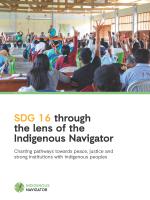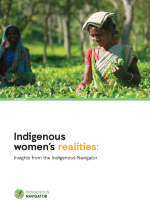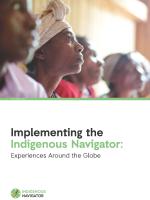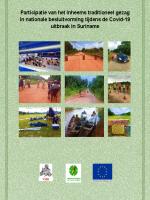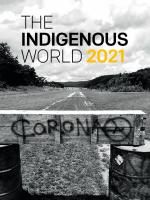SDG 16 through the lens of the Indigenous Navigator
Charting pathways towards peace, justice and strong institutions with Indigenous Peoples
INDIGENOUS PEOPLES AND SDG 16:
Adopted in 2015, the 2030 Sustainable Development Agenda is a plan of action that has people and the planet at its centre, embracing three dimensions of sustainability: economic, social and environmental. Following an inclusive process of intergovernmental negotiations, 17 Sustainable Development Goals (SDGs) were adopted, providing the international community with a framework for tackling the numerous challenges confronting humanity. While all goals are integrated, interdependent and indivisible, Goal 16 has been highlighted as forming the basis for the realization of many of the rights recognized in the United Nations Declaration on the Rights of Indigenous Peoples (UNDRIP) (UN 2021a).
However, around the globe, conflict, insecurity, weak institutions and limited access to justice still threaten sustainable development. The UN Secretary-General 2020 report on progress towards the SDGs shows that millions of people continue to be deprived of their security, human rights and access to justice. The COVID-19 pandemic is likely to increase social unrest and violence (UN 2020a). The global economy has experienced its worst recession in 90 years and vulnerable segments of society have been disproportionally affected. In such a diverging world, characterized by sharpening inequalities, there is a grave danger that we would fail to achieve all SDGs (UN 2021b), including SDG 16 (UN 2020a).
In particular, Goal 16 aims to “promote peaceful and inclusive societies for sustainable development, provide access to justice for all and build effective, accountable and inclusive institutions at all levels” (UN 2015). Its targets cover a wide range of issues, from abuse and violence to public access to information, and vary in scope. For example, while the promotion of the rule of law (target 16.3) encompasses basic principles of legality, birth registration (target 16.9) is a very specific action with a key role in ensuring individual rights, access to justice and social services (UN 2020b), as well as political rights.
Goal 16’s targets, reproduced in Box 1 of the report, comprise critical outcomes which are essential for the achievement of progress across other Sustainable Development Goals (UN 2020b). Considering the importance of achieving Goal 16 in order to guarantee that indigenous peoples are not left behind, as well as the important contributions that indigenous peoples make towards the attainment of this goal, this report dedicates itself to understanding the situation of realization of SDG 16 for indigenous peoples through the lens of the Indigenous Navigator.
The Indigenous Navigator is a framework for community-based monitoring of indigenous peoples’ rights and development. It offers an innovative way for indigenous peoples to share first-hand information and knowledge about their lived realities, thus supporting their efforts to claim their rights. The Indigenous Navigator initiative was launched in 2014 with the support of the European Union. It is led by a consortium comprising the International Work Group for Indigenous Affairs (IWGIA), the Forest Peoples Programme (FPP), the Tebtebba Foundation, the Asia Indigenous Peoples Pact (AIPP) and the Danish Institute for Human Rights (DIHR). This report has been prepared in collaboration with the International Labour Organization (ILO), a partner of the Indigenous Navigator initiative. Since 2017, Indigenous Navigator partners have been working with local organizations in 11 countries2 to support indigenous communities’ efforts to increase understanding and awareness of their rights and enable them to voice their most pressing demands.
The Indigenous Navigator provides access to data that has been collected and shared by indigenous communities themselves through various methodologies, such as focal groups, community assemblies, and individual and household surveys. Indigenous Navigator questionnaires have been answered collectively, as part of a collaborative process. Consequently, the data collected through the Indigenous Navigator provides information on communities’ perception of the implementation of indigenous peoples’ rights. Data from the Indigenous Navigator sheds light on indigenous peoples’ perceptions of their own realities, highlighting key points for attention in policy formulation.
The aim of this report is to identify and discuss the experiences, needs, concerns and aspirations of indigenous peoples in relation to themes pertaining to SDG 16. Part I describes the Indigenous Navigator framework as well as the data collection and analysis methodology. Using the information collected through the Indigenous Navigator and interviews carried out with local partners, Part II looks into specific aspects of the situation of indigenous peoples that are relevant for the realization of SDG 16. Part III identifies key areas for future action and concludes with a number of policy recommendations.

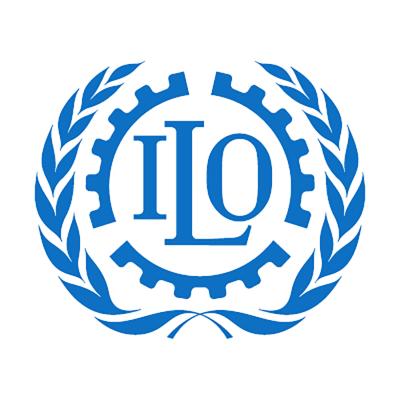
Contact

Gabriela Balvedi Pimentel

